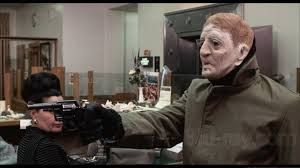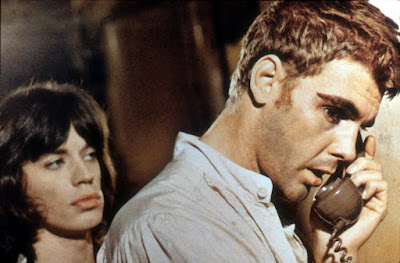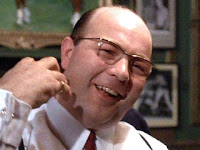 |
| Robert Mitchum in 'The Friends of Eddie Coyle' (1973). |
terrorized Hollywood film crews
All of those elements could and did work in various films set in the big, shiny, bustling American metropolises, but not so much in Boston. Sure, there was “The Boston Strangler,” a ripped-from-the-headlines police procedural that used then-fashionable split screen montages. But that was a psychological study, not nearly as unapologetically raw as “Eddie Coyle.”
Lacking in Allure
You had “Mean Streets,” “The French Connection,” both New York stories, and even “Get Carter,” set in London and Newcastle, England. But, my God, this was Boston, a backwater with an abundance of colleges and universities and a depressed economy.
City folks had been moving out to the suburbs in droves at least 10 years prior. As movie locations go, it was no New York, Los Angeles or San Francisco.
Labor Pains
To make matters worse, labor unions presented a major problem for film crews working in Boston in those days. A production could get shut down by a guy with a broken nose and a blackjack in his back pocket. The Teamsters labor union held Boston film productions in a hammerlock, according to Boston film critic Ty Burr.
Teamster truck drivers smashed windshields and beat up crew members if they didn’t get what they wanted. It appears that the “Eddie Coyle” crew didn’t have significant difficulties with the union — could it be because the Teamsters were Robert Mitchum fans?
A Familiar Kind of Criminal
Despite the drawbacks, British-born director Peter Yates liked Boston as a filming location and remarked that the criminals in Boston were like those in London. They wouldn’t harm others so long as they got the loot they were after — a criminal ethic of a bygone era, he wistfully declaims on the “Eddie Coyle” DVD commentary track.
What changed the perception of Boston as a lackluster setting for a crime story was George V. Higgins’s novel “The Friends of Eddie Coyle” on which the film is based. The book was so highly regarded that it not only put Boston on the crime film map, it inspired a sub-genre of fiction and crime movies — Boston noir, if you will.
Novel Influenced Writers
The novel was a big influence on writers local to his area as well, such as Robert B. Parker (“High Profile,” “Valediction”) and Dennis Lehane (“Mystic River,” “Gone, Baby, Gone”). Elmore Leonard, who was based in Michigan, said “The Friends of Eddie Coyle” was the best crime novel he’d ever read, and it was an inspiration in his own writing.
When Quentin Tarantino adapted Leonard’s novel “Rum Punch” into the film “Jackie Brown,” he changed the lead character’s name from Jackie Burke, as it was in the novel, to Jackie Brown in homage to George Higgins’s book — one of Eddie Coyle’s gun-running cohorts is named Jackie Brown.
A Dialogue Driven Novel
What made Higgins’s book stand out, unlike other crime novels of that era, is that it’s around 80 percent dialogue and the dialogue beautifully defined the story’s characters. Higgins, born and raised in the Boston area, had a sharp ear for the way people talked. He knew their accents and inflections.
Before embarking on a writing career, he was an assistant prosecutor who helped bring a number of Boston-area gangsters to trial. Then he went into private law practice and defended them. He knew how they spoke and how they thought and was skilled at getting the nuances and details of their speech down on paper.
The Rich and the Poor
But what makes “Eddie Coyle” the cornerstone of Boston crime novels and movies is its depiction of two separate but intertwined worlds that are endemic to the city. There’s the Harvard-educated upper class and the struggling working class.
The dingy areas in which Eddie Coyle travels are shown in marked contrast to the glimpses we get of bankers’ comfortable suburban homes. Prior to Higgins’s novel we’d not seen Boston portrayed in such a divided state, at least not in crime novels.
The story takes place in the late 1960s or early ‘70s when the city was especially down at its heels. Director Peter Yates shot the least photogenic sides of the city, unlike “The Thomas Crown Affair” (1968), which presented a tourist’s view of Boston.
The City's Rough Edges
“Eddie Coyle” shows the places that the chamber of commerce didn’t want outsiders to see, the tacky strip malls, dingy bowling alleys, dive bars, seedy cafeterias and the like — where working-class folks circulate. For that it has an authentic, unvarnished look.
Shots are efficient, blunt and not as conspicuously composed as are other films of the genre in that era. It has none of Martin Scorsese’s artfully designed, meticulously lit scenes that somehow make desolation look beautiful. “Eddie Coyle” is as often as not lit by the greenish glow of fluorescent tubes and flickering neon Narragansett Beer signs.
 |
| Peter Boyle as Dillon, and Mitchum. |
Adding Up the Pieces
We see meetings between gangsters and sometimes between gangsters and cops. The story’s episodic nature leaves us to piece together the facts and figure out what’s going on. Eddie Coyle is in only about half of the film.
The rest of the time we witness his so-called friends, their machinations and the jockeying they do to get what they want. The title is ironic — Eddie has no friends, only acquaintances and crime associates on whom he’s come to depend and obviously shouldn’t.
A Page Right Out of the Novel
The film retains the novel’s local flavor due largely to the screenplay’s loyalty to Higgins’s dialogue. Entire scenes are transcribed verbatim from the book, which works because the book often reads like a film treatment.
In the end, the job of adapting the novel to a screenplay was given not to Higgins but to veteran TV writer Paul Monash who had worked on shows as varied as “The Untouchables” and “Peyton Place.”
The Low Man
It’s the dialogue that pulls us into the life of the title character, Eddie Coyle (Robert Mitchum), an almost flat broke gangster who sells guns to criminals. He’s on the bottom rung of the crime syndicate ladder and he doesn’t get much respect from his peers.
Eddie is a family man who lives in a cramped apartment with his wife and three kids in a blue collar town on the outskirts of Boston. The family is his only ray of sunshine in the bleak world that he inhabits. He’s facing a criminal charge that means jail time and he’s desperate to avoid that.
Not only because his family will have to go on welfare, but because people are beginning to wonder if he’s snitching to the police. Once inside prison it would be easy to have him done away with.
Made for the Role
Mitchum is a natural fit for the role of Eddie, the hard-luck gun runner whose life is in a state of increasing turmoil. He was first approached to play the role of Dillion, a bartender whose saloon Eddie frequents to sip draft beer and commiserate.
But Mitchum read the script and decided he wanted to play the title character. As it turned out, his sleepy eyed, world-weary demeanor was made to order for the role.
A 'Noir God'
And what qualifications he had — a bona fide film noir god who in real life did time for a pot bust in the 1940s, further cementing his bad boy credentials. Other actors’ careers would have been devastated by the publicity. For Mitchum, it was merely good press.
He’d recently starred in David Lean’s “Ryan’s Daughter” (1970) playing against type as a cuckolded Irish schoolteacher. Although the film was a financial success the critics eviscerated it. His career was at a lull and he needed a role that would put him back in a favorable light, and Eddie Coyle was just such a role.
A Night on the Town
Peter Boyle ended up playing the shifty bartender Dillon and handled the part magnificently. He was a shoulder for Eddie to cry on, and even gave the gun runner a night on the town prior to his sentencing. But beware of hoodlums bearing gifts.
 |
| Bank robbers use the guns Eddie provided to them. |
To prepare for his role, Mitchum wanted to hang out with notorious Boston mobster Whitey Bulger.
A Word to the Wise
Actor Alex Rocco, who plays a bad guy in the film — he was also Moe Green in “The Godfather” — had a real-life history of association with Boston criminals having grown up in the city and gotten into scrapes with the law.
Rocco gave Mitchum sound advice. “You don’t want to hang out with Whitey.” Instead, he introduced him to Howie Winter, a local gangster with whom Mitchum eventually spent time, all in the name of research.
An Insider's Pointers
Speaking of authoritative advice on the ins and outs of organized crime, Yates found that working in Boston, even with the hassles of dealing with thuggish union men, had its advantages. He recalled attempting to direct a scene depicting a gang hit, and he wasn’t sure how to stage it authentically.
A Teamster truck driver piped up, saying he knew others who did such things, and he offered some advice which the director ended up following. It was at that point that Yates realized that the driver had probably done exactly what he was advising the on-screen talent to do.
That brought a greater sense of realism to the screen — much greater than anyone would have anticipated. And that's what you don’t learn in film school.

















